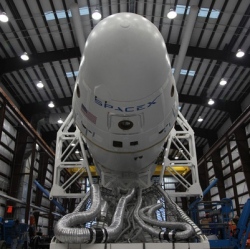
SpaceX has failed to land its Falcon 9 rocket on an autonomous drone ship in the Pacific Ocean after launching the vehicle into space. The vehicle made it to the ship, but came in too hard and broke one of its landing legs. This marks the third time the company has failed to land the rocket upright on the floating ship.
The last two times the company attempted ocean landings, the rockets exploded. SpaceX successfully landed a rocket after a trip to space for the first time in December, but that vehicle had the easier task of landing on solid ground.
Elon Musk noted that a "leg lockout" mechanism failed to latch, causing the rocket to tip over. Waves at the landing site today were 12 to 15 feet high, which may have contributed to difficulties in landing. But when asked if the same scenario would have happened on land, Musk answered, "Probably."
Despite today’s failure, SpaceX will continue to push for sea landings, as it gives the company far more flexibility in how it chooses to recover its rockets post-launch. Landing the Falcon 9 on land is an easier task, but ocean landings help to save on fuel, making them better recovery options for missions that require lots of propellant.
Depending on the type of flight the Falcon 9 will perform, SpaceX wants to be able to pick the landing best suited for each trip.
Today’s mission was successful in sending NASA’s Jason-3 ocean monitoring satellite into orbit. The probe, which was built in cooperation with the National Oceanic and Atmospheric Administration, will measure the ocean’s surface level, to help forecasters better predict major weather events like hurricanes.
